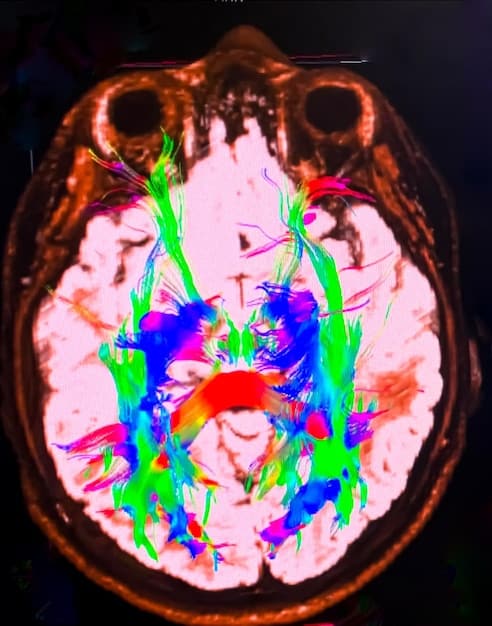Long-Term Health Risks of Repeated Concussions in Contact Sports

Repeated concussions in contact sports can lead to significant long-term health risks, including chronic traumatic encephalopathy (CTE), cognitive impairment, mental health issues, and an increased risk of neurodegenerative diseases.
What are the long-term health risks associated with repeated concussions in contact sports? This is a critical question for athletes, parents, and coaches involved in sports like football, soccer, and hockey, where head injuries are common. Understanding these risks is the first step in protecting the long-term well-being of those who participate in these activities.
Understanding Concussions and Their Immediate Effects
Concussions are traumatic brain injuries (TBIs) caused by a bump, blow, or jolt to the head or by a hit to the body that causes the head and brain to move rapidly back and forth. Understanding what happens during and immediately after a concussion is crucial to grasping the potential long-term consequences.
The Physiology of a Concussion
When a concussion occurs, the brain’s normal function is disrupted. This disruption can cause a variety of symptoms, ranging from mild and temporary to severe and prolonged.
- Neurological Disruption: The impact causes a sudden surge of electrical activity in the brain, disrupting normal neural pathways.
- Chemical Imbalance: There is an alteration in the balance of neurotransmitters and other chemicals in the brain, affecting cognitive and emotional functions.
- Cellular Damage: At a microscopic level, brain cells can stretch and become damaged, especially the axons that transmit signals between neurons.

Common Immediate Symptoms
Immediate symptoms of a concussion can vary widely from person to person. Recognizing these symptoms is vital for prompt medical attention and appropriate management.
- Headache: One of the most common symptoms, often described as a dull ache or intense throbbing.
- Dizziness and Balance Problems: Feeling unsteady or lightheaded, leading to difficulty maintaining balance.
- Confusion and Disorientation: Difficulty thinking clearly, remembering events, or knowing where you are.
- Vision Disturbances: Blurred or double vision, sensitivity to light, or difficulty focusing.
Recognizing the immediate effects of a concussion is paramount in preventing further injury and initiating proper care. The more concussions an athlete sustains, the greater the risk of long-term health problems, which we will explore in the following sections.
Chronic Traumatic Encephalopathy (CTE): A Degenerative Brain Disease
Chronic Traumatic Encephalopathy, or CTE, is a progressive degenerative disease of the brain found in individuals with a history of repeated brain trauma, including concussions. CTE is perhaps the most widely discussed long-term risk associated with concussions in contact sports.
What is CTE?
CTE is characterized by the accumulation of an abnormal protein called tau in the brain. These tau proteins clump together, forming neurofibrillary tangles that disrupt normal brain function.
- Progressive Deterioration: CTE is a progressive disease, meaning its symptoms worsen over time.
- Irreversible Damage: Once CTE has developed, the damage to the brain is irreversible.
- Diagnostic Challenges: CTE can only be definitively diagnosed through a post-mortem examination of the brain.
Symptoms of CTE
The symptoms of CTE can vary significantly from person to person but typically fall into two main categories: cognitive and behavioral.
- Cognitive Impairment: Memory loss, difficulty thinking, problems with planning and judgment.
- Behavioral and Mood Disturbances: Depression, anxiety, irritability, aggression, and impulsivity.
- Motor Problems: In some cases, CTE can also lead to motor symptoms, such as difficulty with balance, speech, and movement.
CTE represents a significant and frightening risk for athletes in contact sports. While not everyone who sustains multiple concussions will develop CTE, the risk increases with each head injury. Understanding CTE and its potential consequences is crucial for making informed decisions about participation in contact sports.
Cognitive Impairment and Decline
Beyond the specific pathology of CTE, repeated concussions can also lead to more general cognitive impairment and decline. These impairments can affect various aspects of daily life, from academic performance to job function.
Impact on Memory and Attention
Concussions can have a significant impact on memory and attention, making it difficult for individuals to learn new information or concentrate on tasks.
- Memory Deficits: Difficulty remembering recent events, names, or instructions.
- Attention Problems: Trouble focusing, easily distracted, and difficulty multitasking.
Executive Function Deficits
Executive functions are higher-level cognitive processes that allow us to plan, organize, and execute tasks. Concussions can impair these functions, leading to difficulties in everyday life.
- Planning and Organization: Struggle to plan ahead, organize tasks, and manage time effectively.
- Decision-Making: Impaired judgment and difficulty making sound decisions.
- Problem-Solving: Difficulty solving problems and adapting to new situations.

Cognitive impairment can significantly impact an individual’s quality of life and ability to function independently. Early recognition and management of these issues are critical to mitigating their long-term impact.
Mental Health Issues and Emotional Well-being
The long-term effects of repeated concussions extend beyond cognitive function to also impact mental health and emotional well-being. These effects can manifest in various ways, including depression, anxiety, and increased risk of suicide.
Depression and Anxiety
Concussions can disrupt the normal functioning of the brain, leading to changes in mood and emotional regulation.
- Increased Risk: Studies have shown that individuals with a history of concussions are at a higher risk of developing depression and anxiety.
- Chemical Imbalance: Disruption of neurotransmitter balance can contribute to mood disorders.
- Emotional Lability: Increased emotional sensitivity and difficulty regulating emotions.
Increased Risk of Suicide
The combination of cognitive impairment, mood disturbances, and other psychological factors can increase the risk of suicide in individuals with a history of concussions.
- Hopelessness: Feelings of hopelessness and despair related to long-term cognitive and emotional difficulties.
- Impulsivity: Impaired impulse control, which can increase the risk of suicidal behavior.
- Social Isolation: Difficulty maintaining relationships and social connections, leading to feelings of isolation and loneliness.
The mental health consequences of repeated concussions are often overlooked but are a critical aspect of the long-term impact of these injuries. Awareness, early intervention, and appropriate mental health support are essential to addressing these issues.
Increased Risk of Neurodegenerative Diseases
Emerging research suggests that repeated concussions may increase the risk of developing other neurodegenerative diseases later in life, such as Alzheimer’s disease and Parkinson’s disease. While the exact mechanisms are still being investigated, there are several theories about how concussions may contribute to this increased risk.
Potential Links to Alzheimer’s Disease
Some studies have found a link between traumatic brain injuries, including concussions, and an increased risk of Alzheimer’s disease.
- Amyloid Plaques: Concussions may accelerate the formation of amyloid plaques, a hallmark of Alzheimer’s disease.
- Inflammation: Chronic inflammation in the brain following repeated concussions may contribute to neurodegeneration.
Potential Links to Parkinson’s Disease
There is also some evidence to suggest that repeated concussions may increase the risk of developing Parkinson’s disease.
- Dopamine Neuron Damage: Concussions may damage dopamine-producing neurons in the brain, which are affected in Parkinson’s disease.
- Protein Aggregation: Similar to CTE, concussions may promote the aggregation of proteins in the brain that are associated with Parkinson’s disease.
While the research in this area is still evolving, the potential link between repeated concussions and an increased risk of neurodegenerative diseases is a significant concern. Further studies are needed to fully understand these connections and develop strategies to mitigate these risks.
Prevention and Mitigation Strategies
Given the significant long-term health risks associated with repeated concussions, prevention is of utmost importance. There are several strategies that can be implemented to reduce the risk of concussions in contact sports and mitigate their potential long-term effects.
Rule Changes and Enforcement
Modifying the rules of contact sports to reduce the risk of head injuries and strictly enforcing these rules is essential.
- Targeting Illegal Hits: Implementing stricter penalties for hits to the head or neck.
- Promoting Fair Play: Encouraging sportsmanship and discouraging intentional head contact.
Improved Equipment and Technology
Advancements in protective equipment, such as helmets and mouthguards, can help reduce the severity of head impacts.
- Helmet Design: Developing helmets that better absorb and distribute impact forces.
- Impact Sensors: Using sensors to detect and measure head impacts in real-time, allowing for early identification of potential concussions.
Education and Awareness
Educating athletes, coaches, parents, and medical professionals about the signs and symptoms of concussions, as well as proper management strategies, is critical.
- Concussion Education Programs: Implementing programs to raise awareness about the risks of concussions and promote safe play.
- Proper Training Techniques: Teaching athletes proper techniques for tackling, checking, and other contact maneuvers to minimize head injuries.
By implementing these prevention and mitigation strategies, we can help protect athletes from the long-term health risks associated with repeated concussions and promote safer participation in contact sports.
| Key Point | Brief Description |
|---|---|
| 🧠 CTE | Progressive brain degeneration from repeated head trauma. |
| 🤕 Cognitive Impairment | Memory loss and attention deficits affecting daily life. |
| 😔 Mental Health Risks | Increased risk of depression, anxiety, and suicide. |
| 🛡️ Prevention | Rule changes, improved equipment, and education. |
Frequently Asked Questions (FAQ)
▼
A concussion is a traumatic brain injury caused by a blow or jolt to the head that disrupts normal brain function, leading to a range of symptoms from headaches to confusion.
▼
There is no safe number of concussions. Each concussion carries potential risks, and the more concussions an individual sustains, the greater the likelihood of long-term problems.
▼
While there is no guaranteed way to prevent CTE, reducing the number of head injuries through rule changes, better equipment, and education can lower the risk of developing this condition.
▼
Rest, both physical and cognitive, is crucial for allowing the brain to recover after a concussion. Avoiding strenuous activities and mentally demanding tasks can aid in healing.
▼
Yes, factors such as age, gender, genetics, and previous concussion history can influence an individual’s susceptibility to concussions and their potential long-term effects.
Conclusion
Understanding the long-term health risks associated with repeated concussions in contact sports is essential for making informed decisions about participation and implementing effective prevention strategies. By prioritizing athlete safety and promoting responsible play, we can minimize the potential for devastating long-term consequences and ensure a healthier future for athletes.





